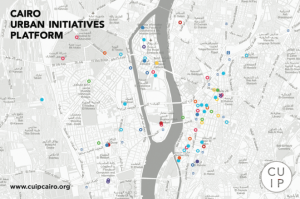
(Photo from CUIP)
With the wide range of festivals, cultural programmes and artistic venues available these days in Cairo, it would be easy to miss an event. Enter CUIP, the Cairo Urban Initiatives Platform, a new shared directory and calendar geared towards making cultural life easier. We contacted Amy Arif, CUIP’s content manager and lead organiser of the event calendar at CUIP, for more details.
“The idea for CUIP was developed by Omar Nagati and Beth Stryker of CLUSTER (Cairo Lab for Urban Studies, Training and Environmental Research) towards the end of 2011,” Arif explained. “They observed that with the revolution came greater room for freedom of expression, which led to a proliferation of new cultural and urban initiatives. With both an influx of funding options for these initiatives and the absence of a clear legal framework, there was a need for a platform to map them out and facilitate the sharing of information and resources.”
Arif pointed out that Stryker and Nagati “worked with 30-40 different initiatives over the last nine months under the umbrella of the CUIP to develop a shared directory and calendar as tools to facilitate future networking.” The platform was then produced by Stryker, Nagati and architect Yasmina Taha, who was integral in building the initiatives directory.
CUIP aims to become the one-stop-shop for all cultural programs and initiatives in Cairo. Arif explained how users would benefit from the platform: “CUIP is essentially a bilingual Arabic/English interactive, user-generated map, a directory and a shared calendar of events. Initiatives are categorised into nine different types and are colour-coded accordingly, including: academic/research, real estate developers, art/culture, etc. Users can browse initiatives by name, type, focus, activity or resource.
“So for instance if you are looking for initiatives that offer a screening space, or a darkroom or training facilities, you will click on the appropriate menu and find a list of these. Each initiative has its own profile page with a mission statement, contact information and address, along with a list of all the events hosted or organised by this initiative. Users can look for events by date, theme or format, such as exhibitions, workshops, concerts or lectures.”
Arif believes that the platform is a useful alternative to Facebook since, “it does not require signing up to follow events being organised by initiatives, and it allows for information to be searched and visualized via an interactive map.”
People can sign up their own initiatives on the website, enabling them “to manage their own page and post their own events. Even without a login, users can post events or add initiatives, but these posts have to be reviewed first before they are published. We encourage people to contact us to get a login to post their events to the calendar, which is largely user-generated,” Arif explained.
In addition to Arif, Nagati and Stryker, others were also involved in the project: Hanaa Gad who translated much of the website content, and Laura Cugusi, who was program coordinator of the first meeting of Cairo Urban Initiatives organised by Cluster. There is also a list of the involved initiatives on the CUIP website.




